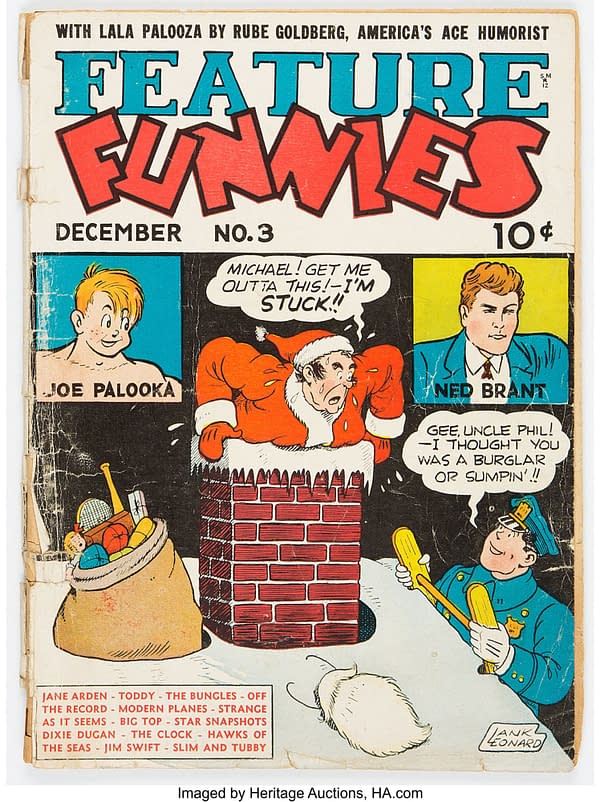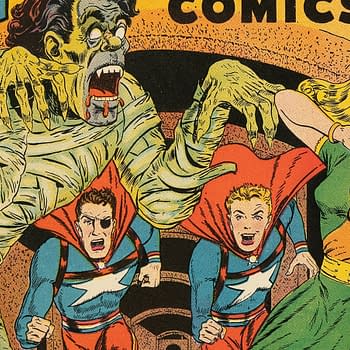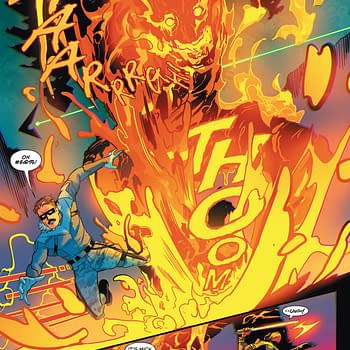Posted in: Comics, Heritage Sponsored, Vintage Paper | Tagged: golden age, quality comics, the clock
The Clock's New Beginning in 1937's Feature Funnies #3, at Auction
The Clock was the first masked hero of the Golden Age of American comic books. The character was created by George Brenner and first appeared from publisher Comics Magazine Company in Funny Pages #v1#6 and Funny Picture Stories #1, both cover-dated November 1936. These issues hit newsstands 18 months before Superman's debut in Action Comics #1, and The Clock anchored a little-known attempt to do comic book-like comic sections for newspapers over three years before Spirit Sections. This prior attempt also included Will Eisner's "The Brothers 3" and almost certainly influenced the development of the Spirit Section concept when both Brenner and Eisner connected with Everett "Busy" Arnold at Quality Comics. That's where Brenner and The Clock ended up after the failure of Comics Magazine Company and the character made its Quality Comics debut in Feature Funnies #3. There's an affordable copy of Feature Funnies #3 Incomplete Condition: PR and many other Clock appearances in Feature Funnies and Feature Comics up for auction in the 2022 August 21-22 Sunday & Monday Comic Books Select Auction #122234 at Heritage Auctions.

George Brenner's first comic book work came via Eisner and Iger Studio for Wow–What a Magazine #2, cover-dated August 1936. The Clock debuted in Comics Magazine Company's Funny Pages #v1#6 and Funny Picture Stories #1, both cover-dated November 1936. Comics Magazine Company had been founded by John F. Mahon and William H. Cook, who were previously the business manager and managing editor of Malcolm Wheeler-Nicholson's National Allied Newspaper Syndicate and More Fun Magazines.
That experience plays into what happened next, because Mahon and Cook launched a comic book-like Sunday newspaper comic section about five months after the debut of Funny Picture Stories #1. Little is known about this project, which seems to have been used by very few newspapers. The Clock was the star of an eight-page color section that debuted in newspapers including the Lake Charles American Press and the Deadwood Pioneer-Times. The "Alias the Clock" story from Funny Picture Stories #1 was the feature of the first section, which appeared in the Deadwood Pioneer-Times on February 28, 1937, and the Lake Charles American Press on March 5, 1937. The Deadwood Pioneer-Times ran only four of these comic sections on consecutive Sundays, which have various features taken from Funny Picture Stories, concluding with a second The Clock feature on March 21. Numbering on existing Funny Picture Stories comic sections implies that at least 12 sections were prepared. It's unclear whether Eisner's "The Brothers 3" section, which was designated as "Set No. 11" ever ran, as the known existing copy does not contain a specific newspaper "localization" such as the front page newspaper masthead or the back page, which also seems to have also been left to individual newspapers to localize.
Cover-dated June 1937, Funny Pages #11 was the last Comics Magazine Company appearance of The Clock. The publisher ended its active titles (Funny Pages, Funny Picture Stories) this month. A magazine publisher called Ultem Publications, acquired Funny Pages and Funny Picture Stories and continued both titles with issues cover-dated 1937, but continued none of the interior features from the title and used none of the artists who had been associated with them. Ultem acquired Harry A. Chesler's Star Comics and Star Rangers at this time as well, and Chesler would take over editing the entire short-lived Ultem line using his studio creators.
Still, the decision by Ultem not to attempt to continue any of the Comics Magazine Company-established features, particularly The Clock, is an interesting one. In what is now an infamous historical mystery, Cook and Mahon had brought material from a few More Fun Magazines features with them to their new venture, and some but not all of those artists continued to work on those features at Comics Magazine Company. Most famous among these is Jerry Siegel and Joe Shuster's Dr. Occult, who had debuted in DC Comics' New Fun Comics #6 cover-dated October 1935. The character appeared in The Comics Magazine #1 as Dr. Mystic in a story that then continued in More Fun Comics #14-17. It's worth noting that Ultem Publications seems to have had plenty of appetite for legal risk, as this era saw them engage in Time, Inc. v. Ultem Publications, Semler v. Ultem Publications, Inc. and Ultem Publications, v. Arrow Publications. Subsequent events would also seem to imply that Ultem had access to at least art or stats of the Comics Magazine Company titles, as when Ultem quickly threw in the towel and sold its titles to Centaur, The Clock made a single appearance from that publisher in Keen Detective Funnies #v1#8 (1938) which reprinted the character's Funny Picture Stories #1 "Alias the Clock" story. The lack of follow-up there may imply that Brenner and/or Busy Arnold, who had been publishing The Clock at Quality Comics for several months by that time, shut the Centaur attempt down.
Further legal intrigue may also be implied by the appearance of a very Clock-like character called The Hawk created by George Brenner in his first work for Quality Comics in Feature Funnies #2. The Hawk never appeared again, and The Clock debuted in the next issue, Feature Comics #3. This sequence of events may imply that rights for The Clock were unclear in the wake of the Comics Magazine Company quagmire. According to Arnold's own account in The Steranko History of Comics volume 2, he had contacted William H. Cook, who put him in touch with many of the Comics Magazine Company's creators including Brenner. The same month that The Clock debuted in Feature Comics #3, Eisner and Iger Studio began packaging Brenner's The Clock with their other studio material for Editors Press Service's UK and Australian comic weekly Wags, which may further support the notion that any lingering rights issues had been clarified at this time.
Brenner's creation predated well-known early superheroes such as Batman and Superman, and the character's popularity helped pave the way for their eventual arrival. By some accounts, The Clock was also a direct influence on the creation of The Spirit. While the character has faded into obscurity over the years, he remains an important part of comic book history and is deserving of more attention, and there's an affordable copy of Feature Funnies #3 Incomplete Condition: PR and many other Clock appearances in Feature Funnies and Feature Comics up for auction in the 2022 August 21-22 Sunday & Monday Comic Books Select Auction #122234 at Heritage Auctions.

Feature Funnies #3 Incomplete (Chesler, 1937) Condition: PR. Will Eisner art. Christmas cover. Joe Palooka appearance. Cover detached and spine half-way split. Missing centerfold. Incomplete. Overstreet 2022 GD 2.0 value = $103.
















